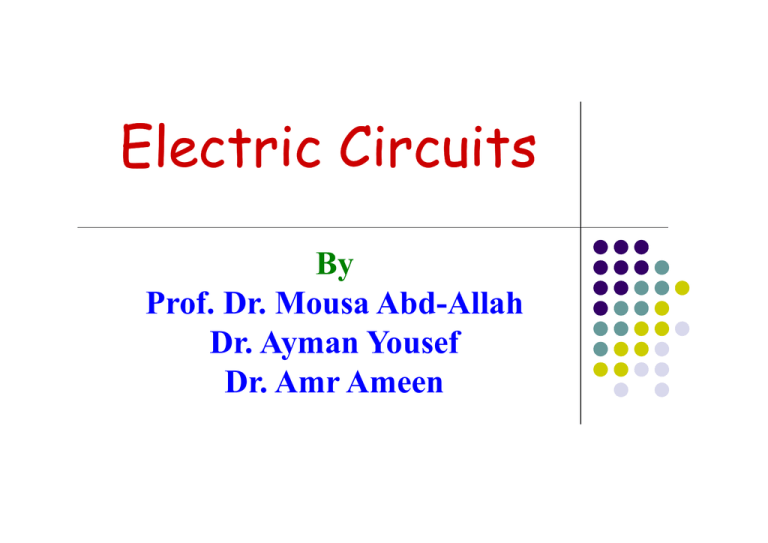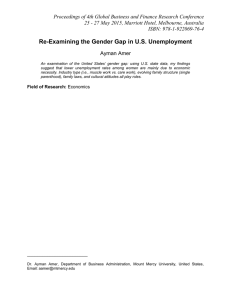Ch 1. Sinusoids, phasors and Resonance_Part 1
advertisement

Electric Circuits By Prof. Dr. Mousa Abd-Allah Dr. Ayman Yousef Dr. Amr Ameen Contents Ø Ø Ø Ø Ø Ø Ø CH1: Sinusoids, Phasors and resonance CH2: Sinusoidal steady-State Analysis CH3: AC Power Analysis CH4: Three Phase Circuits CH5: Transient Response of Circuits CH6: Fourier Analysis and Circuit Applications CH7: Two-Port Circuits Electric Circuits Dr. Ayman Yousef 2 References q q q Mahmood Nahvi, Joseph A. Edminister, “ Electric Circuits” , Schaum’s Outlines, Mc Graw Hill. ISBN: 9780071633727, 2011. James W. Nilsson, Susan A. Riedel, “ Electric Circuits” , Prentice Hall, New Jersey, ISBN:9780137050512-0137050518, 2011. Jhon Bird, “ Electrical Theory and Technology” , Elsevier, Oxford, ISBN:9780080549798-0080549799, 2007. Electric Circuits Dr. Ayman Yousef 3 Chapter I Sinusoids , Phasors and Resonance By Dr. Ayman Yousef Sinusoids Electric Circuits Dr. Ayman Yousef 5 Alternating (AC) Sinusoidal Waveforms Period of a Waveform l Period (T): The time interval between successive repetitions of a periodic waveform (time required for completing one full cycle). l One period occupies exactly 360º of a sine waveform. Period frequency l Cycle: The portion of a waveform contained in one period of time. Electric Circuits Dr. Ayman Yousef (Sec) 6 Alternating (AC) Sinusoidal Waveforms Frequency of a Waveform l Frequency (f): The number of cycles that occur in 1 sec (number of cycles that is completed each second.) (Hertz) l This figure shows four cycles per second, or a waveform that has a frequency of 4 Hz. Electric Circuits Dr. Ayman Yousef 7 Sinusoids ØA SINUSOID is a signal that has the form of the sine or cosine function. Electric Circuits Dr. Ayman Yousef 8 Instantaneous Value of a Wave Instantaneous value: The magnitude of a waveform at any instant of time; denoted by the lowercase letters (v1, v2). Peak amplitude: The maximum value of the waveform as measured from reference horizontal line (the greater value of Instantaneous value), denoted by the uppercase letters Vm. where φ v is the phase angle Electric Circuits Dr. Ayman Yousef 9 Phase of Sinusoids l OA represents a vector that is free to rotate anticlockwise about 0 at an angular velocity of ω rad/s. A rotating vector is known as a phasor. l Any quantity which varies sinusoidally can thus be represented as a phasor. Electric Circuits Dr. Ayman Yousef 10 Rotating of single phasor Electric Circuits Dr. Ayman Yousef 11 Rotating of Two phasors Electric Circuits Dr. Ayman Yousef 12 Phase of Sinusoids Ø Only two sinusoidal values with the same frequency can be compared by their amplitude and phase difference. Ø If phase difference is zero, they are in phase; if phase difference is not zero, they are out of phase. Electric Circuits Dr. Ayman Yousef 13 Phase of Sinusoids Ø The terms lead and lag are used to indicate the relationship between two sinusoidal waveforms of the same frequency plotted on the same set of axes. ØThe cosine curve is said to lead the sine curve by 90° . ØThe sine curve is said to lag the cosine curve by 90° . Ø90 is referred to as the phase angle between the two waveforms. ØWhen determining the phase measurement we first note that each sinusoidal function has the same frequency, permitting the use of either waveform to determine the period. ØSince the full period represents a cycle of 360° . Electric Circuits Dr. Ayman Yousef 14 Phase of Sinusoids ØConsider the sinusoidal voltage having phase φ , • v2 LEADS v1 by phase φ . • v1 LAGS v2 by phase φ . • v1 and v2 are out of phase. Electric Circuits Dr. Ayman Yousef 15 Average Value of a Wave Suppose a time-varying function f(t) is defined on the interval a ≤ t ≤ b. The area A, under the graph of f(t) is given by the integral Electric Circuits Dr. Ayman Yousef 16 Average Value of Sine Wave T 1 Vav = ∫ v(t )dt T0 The average value of only half a cycle of the Sine wave is given by: The average value of the full cycle of the wave will be zero because the sine wave symmetrical about zero. Electric Circuits Dr. Ayman Yousef 17 Root-mean-square value of sin wave l The R.M.S. (or effective) value of an alternating voltage or current (AC) is the value which would produce the same amount of heat energy in a resistor as a direct voltage or current (DC) of the same magnitude. R.M.S. (3) Root (2) Mean (1) square Electric Circuits Dr. Ayman Yousef 18 Ex.1: Find the amplitude, phase, period, and frequency of the sinusoid: v(t)=12cos(50t+10o) Solution Electric Circuits Dr. Ayman Yousef 19 Ex.2 : Calculate the phase angle between v1 = -10 cos(ωt+50o) & v2 = 12 sin(ωt-10o) state which sinusoid is leading Solution Electric Circuits Dr. Ayman Yousef 20 Complex Numbers Electric Circuits Dr. Ayman Yousef 21 Complex Numbers ØA complex number may be written in RECTANGULAR FORM as: ØA second way of representing the complex number is by specifying the MAGNITUDE (r) and the ANGLE (θ ) in POLAR form. ØThe third way of representing the complex number is the EXPONENTIAL form. • x is the REAL part. • y is the IMAGINARY part. • r is the MAGNITUDE. • φ is the ANGLE. Electric Circuits Dr. Ayman Yousef 22 Complex Numbers ØA complex number may be written in RECTANGULAR FORM as: Electric Circuits Dr. Ayman Yousef 23 Complex Number Conversions ØMathematical operations on complex numbers may require conversions from one form to other form. ØConverting Rectangular to Polar: ØConverting Polar to Rectangular : Electric Circuits Dr. Ayman Yousef 24 Mathematical Operations of Complex Numbers ØMathematical operations for conversions complex numbers from one form to other form. ØAddition and Subtraction must be on the Rectangular form. ØMultiplication and Division must be on the Polar form. Electric Circuits Dr. Ayman Yousef 25 Adding Phasors Graphically ØAdding sinusoids of the same frequency is equivalent to adding their corresponding phasors. V=V1+V2 V1 = V1∠ − 45o v V2 = V2 ∠30o v Electric Circuits Dr. Ayman Yousef 26 Phasors Electric Circuits Dr. Ayman Yousef 27 Phasors Ø The phasor is a complex number that carries the amplitude and phase angle information of a sinusoidal function. Ø Phasor is the mathematical equivalent of a sinusoid with time variable dropped. Ø Phasor will be defined from the cosine function in all our proceeding study. Ø If a voltage or current expression is in the form of a sine, it will be changed to a cosine by subtracting from the phase. Electric Circuits Dr. Ayman Yousef 28 Phasors ØPhasor representation is based on Euler’s formula. ØEuler's formula indicates that sinusoids can be represented mathematically by the sum of two complex-valued functions Given a sinusoid v(t)=Vmcos(ω t+φ ) Electric Circuits Dr. Ayman Yousef 29 Phasors Ø Given the sinusoids i(t)=Imcos(ω t+φ I) and v(t)=Vmcos(ω t+ φ V) we can obtain the phasor forms as: Electric Circuits Dr. Ayman Yousef 30 Phase Difference of a Sinusoidal Waveform l The current, i is lagging the voltage, v by angle Φ and in our example above this is 30o. l So the difference between the two phasors representing the two sinusoidal quantities is angle Φ and the resulting phasor diagram will be. Electric Circuits Dr. Ayman Yousef 31 Ex. 3 : Transform these sinusoids to phasors: (a) i = 6 cos(50t-40o) (b) v = - 4 sin(30t+50o) Electric Circuits Dr. Ayman Yousef 32 Ex.4: Given i1(t)=4cos(ωt+30o) A, and i2(t)=5sin(ωt-20o) A , find their sum. Electric Circuits Dr. Ayman Yousef 33 Phasor Relationships for Circuit Elements Electric Circuits Dr. Ayman Yousef 34 Phasor Relationships for Resistor Electric Circuits Dr. Ayman Yousef 35 Phasor Relationships for Resistor Time Domain Frequency Domain Electric Circuits Dr. Ayman Yousef 36 Phasor Relationships for Inductor Where the Inductive reactance is: Electric Circuits Dr. Ayman Yousef 37 Phasor Relationships for Inductor Electric Circuits Dr. Ayman Yousef 38 Phasor Relationships for Capacitor Where the capacitive reactance is: Electric Circuits Dr. Ayman Yousef 39 Phasor Relationships for Capacitor Electric Circuits Dr. Ayman Yousef 40 Phasor Relationships for Circuit Elements Electric Circuits Dr. Ayman Yousef 41 Phasor Relationships for Circuit Elements Electric Circuits Dr. Ayman Yousef 42

